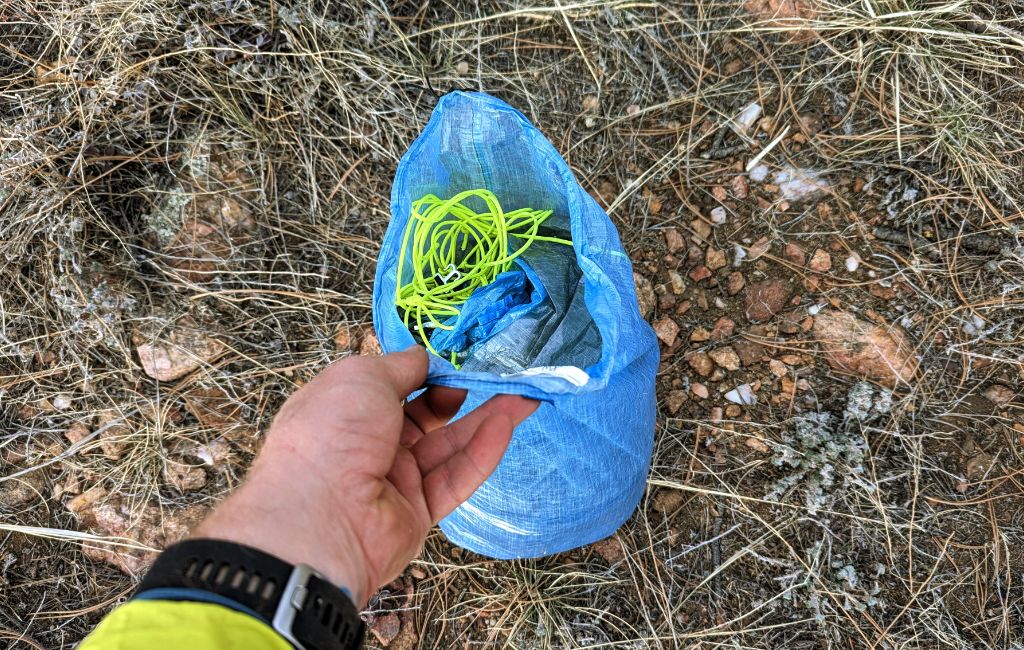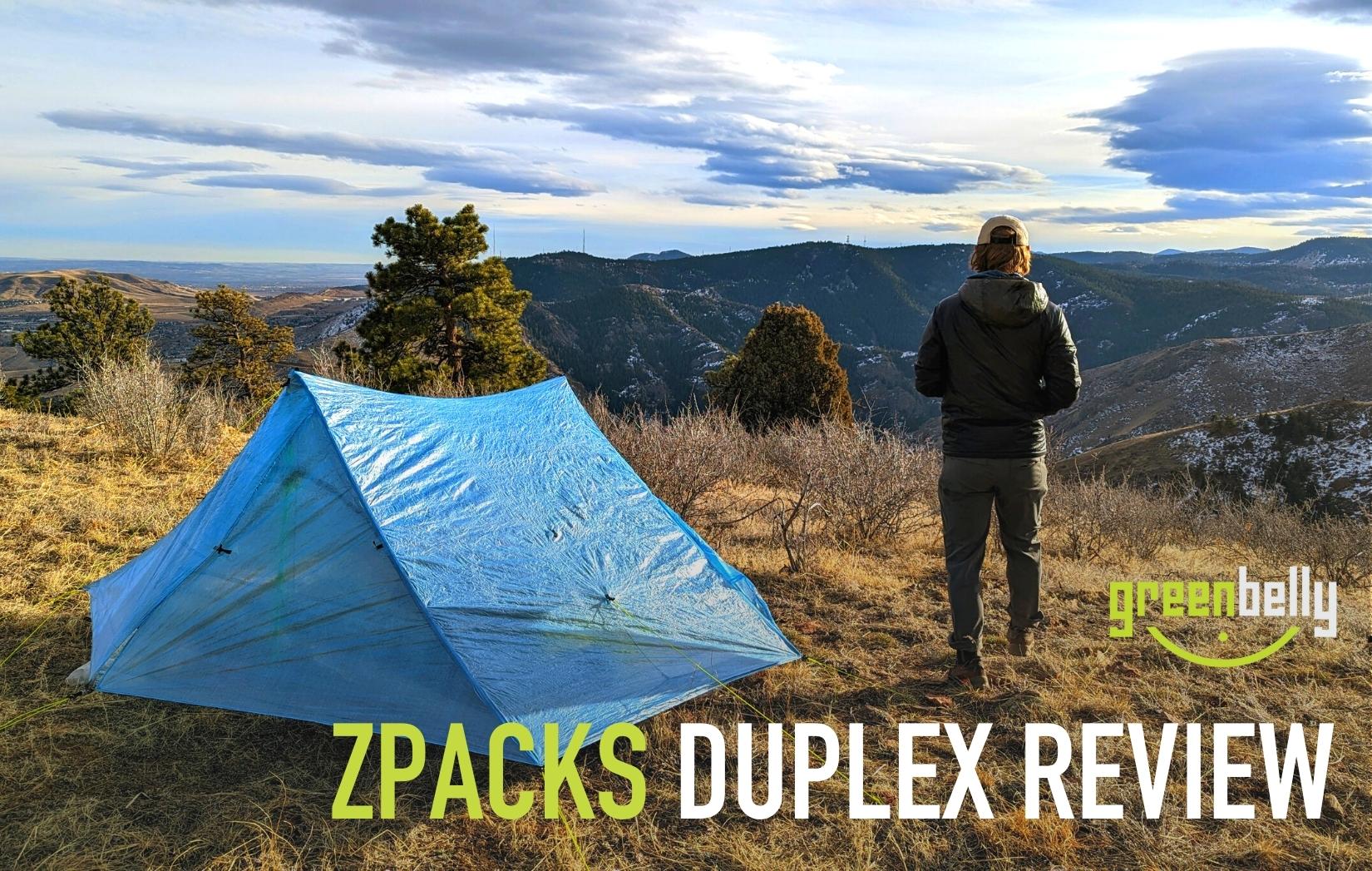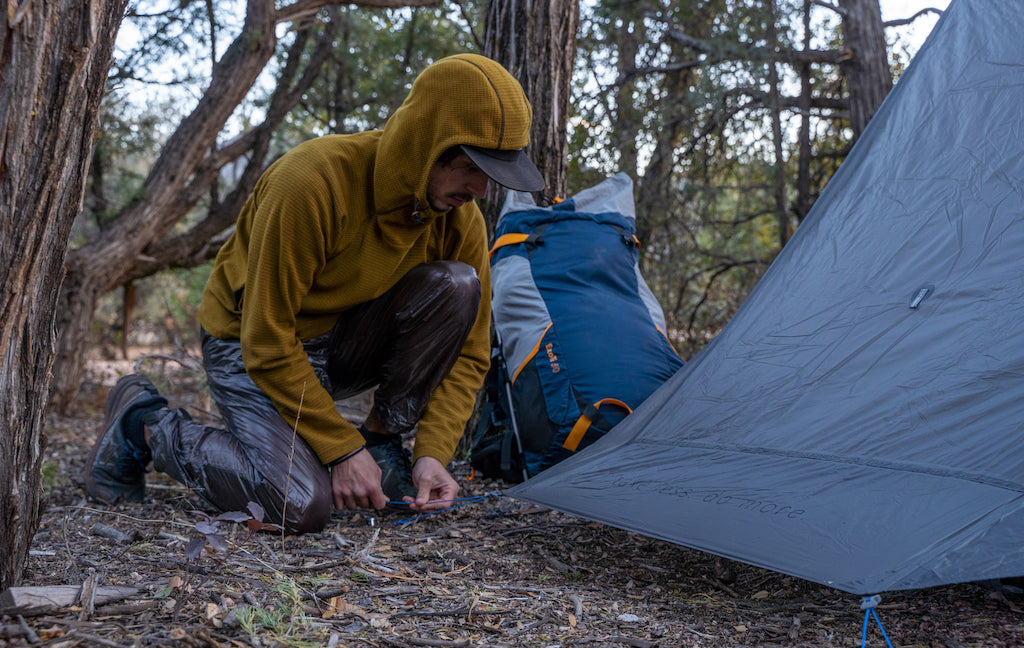The Zpacks Duplex is one of the lightest two-person tents available and is wildly popular with thru-hikers and ultralight backpackers. It’s single-walled, sets up with two trekking poles, and is made of Dyneema® Composite Fabric (DCF). It feels like a palace for solo hikers and is big enough for two hikers to share.
Product Overview
Zpacks Duplex
Price: $699

✅ Ultralight
✅ Enough room for two hikers with gear
✅ Stormproof
✅ Two entrances and two vestibules
❌ Expensive
❌ Doesn’t come with stakes
❌ Requires 8 stakes to pitch
KEY SPECS
- Capacity: 2 person
- Packed Weight: 1 lb 2.5 oz
- Dimensions: 45" wide, 90” long, 48" high at peak, 28.1 square foot floor
- Type: Single wall
- Materials: Dyneema® Composite Fabric, Nano-Noseeum Insect Netting
- Floor Denier: 1.0 oz/square yard Dyneema® Composite Fabric (tent footprint not required)
- Seams: Sewn and seam taped
- Guy-lines included? Yes
- Stakes included? No. This tent requires 8 stakes.
The Zpacks Duplex is one of the lightest two-person tents available. It weighs 19.1 (1 lb 3 oz) ounces according to my home scale. It has two doors, and two large vestibules, and is more than roomy enough for two hikers.
If you’re sleeping in this tent alone, there’s enough space inside to move around, even with all your gear in the tent.
It pitches with two trekking poles and eight tent stakes. This tent is easy to set up and can be pitched very quickly in case of fast-approaching storms. It’s made of Dyneema® Composite Fabric, or DCF, a very waterproof and relatively durable tent material.
This tent is ubiquitous on long trails because it’s one of the best tents available. It does not pack down very small, though. Fully compressed, it’s about the size of a basketball. It is also one of the most expensive tents you’ll find.
This still is an excellent choice if you have enough money in your gear budget. However, this tent may be too expensive for some hikers.
To see reviews on other ultralight tents, check out our Best Ultralight Tents post.
Performance Test Results
What We Tested:

How We Tested:
I have thru-hiked the Pacific Crest Trail, Continental Divide Trail, the Colorado Trail three times, and the Grand Enchantment Trail, along with countless shorter backpacking trips. I tested the Zpacks Duplex in autumn and winter on a series of backpacking trips in Colorado and Arizona. The weather was cool, and I experienced many cold, rainy nights. There was snow on the ground from early-season storms, and I experienced some fresh snow falling as well.
Weight: 10/10
I weighed this tent on my home scale and compared it to the claimed weight listed on the Zpacks website. I also weighed the stuff sack separately to see what the absolute lightest this tent could be on the trail. I removed the center guylines and weighed them since they aren’t technically needed to pitch the tent.
The trail weight of the Duplex is 19.1 ounces, according to my scale. Without the stuff sack (.3 ounces), this tent weighs 18.8 ounces. Without the two center guylines (.3 ounces), this tent weighs 18.5 ounces. Zpacks’ claimed weight of the Duplex is 18.5 ounces.
This weight does not include the eight (or six if you remove the center guylines) stakes required to pitch this tent. Even with eight stakes, this tent weighs well under 1 ½ pounds, though. The eight stakes I use with this tent weigh 2.8 ounces, for a total trail weight of 21.9 ounces.

Based on my scale, the Zpacks Duplex Tent weighs 19.1 ounces, but according to Zpacks, it weighs 18.5 ounces.
This tent has everything two hikers would want, with nothing extra to add weight. It is a single-wall shelter with a mesh enclosure that connects the bathtub floor to the main tent body. The bathtub floor and tent body are made with DCF, which is incredibly lightweight, waterproof, and strong.
The tent has two zippered entrances and two vestibules. The storm doors are zipperless, which also saves weight. Both ends of the tent have an extra tie-out in the middle to create more interior space at the ends of the tent where your feet and head will be. Though these tie-outs aren’t necessary, they dramatically increase the amount of head and foot room.
There aren’t many tents that can comfortably fit two people and gear that weigh as little as the Duplex. Even compared to one-person tents, there aren’t many that are as light as this. Compared to other Dyneema® tents, this tent weighs a comparable amount. However, there aren’t many DCF tents out there, and even fewer are as readily available as the Duplex.

Price: 6/10
The Duplex is one of the most expensive tents you can buy. There are a handful of tents out there that are more expensive than this, but not many. There are tons of hikers out there that have bought a Duplex tent. I think it’s probably worth it for most people to buy this tent, but it is definitely expensive.
Dyneema® Composite Fabric or DCF is arguably the best tent material available. There isn’t any other material that’s as light, waterproof, or strong as DCF. Because of this, you pay a premium for DCF gear, and that’s certainly the case with the Duplex.
When compared to other DCF tents, the Duplex is comparably priced. There are some DCF tents available that cost less than this tent, but all DCF tents are expensive. DCF is an expensive material, and there isn’t a huge demand for DCF fabrics since it is so expensive.
When you compare the Duplex to other tents made of less expensive materials, it seems absurdly expensive. Many tents use a similar design as the Duplex but less costly materials. These tents can cost less than half as much as the Duplex. You don’t need two tents, but you could buy two tents for the price of one Duplex.

The Zpacks Duplex Tent is priced at $699, which might be very expensive for some hikers.
Packability: 7/10
The Duplex is very packable in terms of weight, but it doesn’t pack down very small. Rolled and packed into its stuff sack, this tent is an approximately 7-inch wide, 10-inch long cylinder. Dyneema® is infamously difficult to pack away. Fortunately, the Duplex comes with an oversized stuff sack to make it as easy as possible to pack.
DCF is just not very packable. You must roll DCF to pack it away rather than simply stuffing it. This, and the material's stiffness, cause it not to be as packable. I’ve had other DCF tents that are feather-light but also don’t pack down very small.
This is not a small tent. It will take up about as much space in your pack as a down sleeping bag. This is surprisingly bulky, considering it weighs 19 ounces. There isn’t much you can do to make this tent less bulky when packed into its stuff sack, either. You can fold it flat and not use the stuff sack, but I wouldn’t recommend that because DCF isn’t very durable in terms of abrasion. It’s best to simply live with the fact that you have a basketball-sized tent taking up that much room in your pack.
I recommend packing this tent with all its guylines in the stuff sack and putting it near the bottom of your pack, on top of your sleeping bag. I often pack my stakes away with my tent, but it’s best practice to pack them separately since they can tear the tent material.
If packability is your top concern, a silnylon tent is the most packable. An ultralight silnylon tent will pack down into a considerably smaller package than the Duplex. For example, I have a silnylon tent that weighs nearly twice as much as the Duplex but packs to half the size.

Zpacks Duplex Tent when packed down.
Design: 9/10
Ease of Set Up: 9/10
The Duplex is very easy to set up. The first time I set up this tent, I pitched it in under two minutes. If you have experience pitching other non-freestanding trekking pole tents, this will be easy to set up for you, too.
Everything is symmetrical on this tent, which makes pitching it a breeze. You don’t have to set your trekking poles at different lengths or retention guylines repeatedly. You can easily set this up yourself, too. Some trekking pole tents are much more finicky when pitching, but the simple A-frame design of the Duplex makes it easy to set up.
There are a lot of guylines you need to stake down when pitching this tent, but you really only need six stakes to get the initial pitch. Eight stakes is a lot, but that’s pretty comparable to other similar-sized trekking pole tents.

Ease of Entry & Exit: 9/10
The Duplex has two doors, one on each side of the tent. It has u-shaped zipper doors in the bug mesh that arc most of the length of the sides of the tent. I found these doors very easy to get in and out of. Since they open so wide, you can get out of the tent from each of its four corners. The trekking poles do block the center of this doorway, but the amount of space on either side of the pole is large enough to climb out.
The storm doors do not have a zipper. Instead, they use a double-hooked piece of hardware to secure. These hooks grab a D-ring on the corner of each storm door. The storm doors overlap at the top, so they keep your vestibule from getting wet as well as a zippered vestibule.
Compared with other trekking pole tents, the Duplex is easier than most to enter and exit. The zipperless storm doors make getting out of your tent easier than zippered doors, where you have to reach a zipper and slide it to the top of the tent to get out. Some trekking pole tents have tiny zippered closures in their bug mesh, but the Duplex has huge zippered openings that make getting into the vestibule easier than most of its competitors.

Headspace: 10/10
The Duplex has a ton of headspace. The amount of interior space in this tent is pretty incredible. It’s significantly longer than every other ultralight tent I’ve been inside, and it’s still lighter than most competing models.
The floor is a whopping 7 ½ feet long. I’m 5’9” and used to sleeping in ultralight tents with about six feet of floor length. There are tons of space between my head and the sloping tent walls when lying down in this tent. The tie-outs on the center of the head and foot side walls create even more headspace if you use them.
When sitting up, this tent is about the same height as other ultralight trekking pole tents. It’s 48 inches high in the center, beneath the ridgeline. However, many other ultralight tents have less space at their maximum tent height. With the Duplex, there is a lot of space in the center of the tent that is the maximum height.
I’m easily able to sit up in the center of the tent. There’s more than enough room for two people to sit up inside this tent. I’ve spent many rainy days inside this tent with another hiker, and it never felt cramped.

Zpacks Duplex Tent's headspace.
Footspace: 10/10
When sleeping, my feet are farther from the tent walls than they are with most other ultralight tents. This tent doesn’t have a head or foot side, so everything I said about head space while lying down also applies to foot space.
I’ve never had a problem with the foot box of my sleeping bag rubbing on the tent walls while I sleep in this tent. I can’t say the same about most other tents I’ve slept in, especially not ultralight backpacking tents.

Footspace of the Zpacks Duplex Tent.
Vestibules: 9/10
The Duplex has two roomy vestibules. These vestibules have adequate space for two backpacks, shoes, and other hiking gear. When sleeping in this tent with two people, you can leave everything in one vestibule and still have an open vestibule for cooking and easy access into and out of the tent.
The vestibule doors don’t zip shut. Instead, you clip the overlapping vestibule doors at the bottom. I find this easier to operate than a zipper, and it’s much more durable than a zipper. I’ve had multiple vestibule zippers fail during through hikes. Fewer zippers on a tent are better for this reason.
Compared to other ultralight tents, the Duplex has more total vestibule space than most. This is the lightest tent available that has two vestibules.

There are two roomy vestibules in the Zpacks Duplex Tent.
Other Features: 8/10
The Duplex also has two interior mesh pockets. I like to store the tent stuff sack in this pocket after I pitch it. Other than these interior pockets, there are few other features than those listed above. Other tents have more features, but they aren’t nearly as light as the Duplex.

Zpacks Duplex Tent's interior mesh pocket.
Material: 9/10
The Duplex is made of Dyneema® Composite Fabric with Nano-Noseeum Insect Netting for the bug net enclosure. DCF is not unique to Zpacks tents. If you buy a Dyneema® tent from another tent maker, it will be the same material.
The bathtub floor uses 1.0 ounce per square yard DCF. The tensile strength of this material is 104 pounds per inch. The puncture strength is 3.5 pounds. It has a hydrostatic head of 20,000 mm per inch. This heavier denier tent floor material can be used without a footprint.
The upper tent body uses .55 ounces per square yard DCF. The tensile strength of this fabric is 63 pounds per inch. The puncture strength is 1.8 pounds. It has a hydrostatic head of 15,000 mm per inch.
As I said above, DCF is very expensive. The fact that it’s made of DCF makes it one of the most costly tents out there, but also one of the most waterproof and storm-worthy tents available. A DCF tent like this one will last at least the duration of a long-distance thru-hike, probably longer if you take good care of it.

Dyneema® Composite Fabric or DCF is arguably the best tent material available and is probably the reason why the Zpacks Duplex Tent costs more than other tents available in the market today.
Durability & Weather Resistance: 9/10
Weather Resistance: 9/10
The Duplex performs very well in rain, wind, storms, and other bad weather. I spent several nights in this tent on a rainy winter backpacking trip in Arizona. It rained all night on multiple nights, but this tent kept me and my gear dry.
Compared to sil-nylon tents, this tent is much more waterproof. If you happen to brush against the inside of this tent when the outside is wet, you won’t get nearly as wet as you do with sil-nylon or other tent materials.
This tent can withstand very windy conditions, too. The sloped canopy causes the wind to blow over the tent and not catch the walls. And since it has eight guylines, you can get a very tight pitch. This means the tent won’t flap in the wind as much. In extremely windy conditions, I recommend putting rocks on top of all your stakes so the wind doesn’t pull them out of the ground. This is the case with any tent, but it’s also true of the Duplex.
In extremely bad weather, you can pitch this tent slightly lower to the ground to prevent air from blowing into the tent. To do this, shorten your trekking poles to less than the recommended 48" and tighten all the guylines. The goal is to get the vestibule storm doors as close to the ground as possible.

Durability: 8/10
This tent will last for at least one 2,000+ mile thru-hike. I’ve seen the same Duplex tent last for multiple thru-hikes, but it will probably have to be repaired to last for that long. DCF is a very strong material and is very tear-resistant. However, since you must roll this tent to pack it, it is prone to getting small pin-sized holes in the spots where it’s consistently creased. These pinholes are easily patchable with DCF repair tape, but they will happen with this tent or any other DCF tent.
You should try not to roll this tent up the same way every time you pack it. If you can manage this, you’ll be less likely to see pinholes form in the DCF as quickly. But, small wear holes in DCF are common and seem to be almost inevitable. I’ve been in a Duplex tent with some small pinholes during a storm and stayed dry, but I could see tiny drops of water slowly forming below the pinholes.

What's included in the package on purchase:
- Tent
- Stuff sack
- Eight guylines, attached to tensioners
- DCF repair tape
This tent does not come with tent stakes, poles, or any other accessories.

The Zpacks Duplex Tent's guylines and DCF repair tape inside its stuff sack.






 650-Calorie Fuel
650-Calorie Fuel



